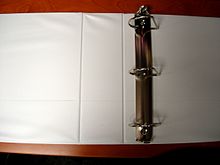- Ring binder
-
Ring binders (pronounced BINE-der) (sometimes called files in Britain) are folders in which punched pieces of paper may be held by means of clamps running through the holes in the paper. These retainers are usually spring-loaded, frequently circular (some rings are D-shaped, others are actually rods), and may have additional latching systems.
Binders come in many standard sizes with respect to both capacity and paper size. Most countries use a two or four hole system for holding A4 sheets. The most common type in Canada and the United States is a three ring system for letter size pages (8½" × 11"). A standard 8½" × 11" sheet of paper has three holes with spacing of 4¼". The lever arch system is particularly useful for larger amounts of paper. Many personal organizers and memorandum books use a six- or seven-hole system, including Filofax, the FranklinCovey Franklin Planner, and Day-Timer. These above mentioned systems have the rings on the left side of the papers as one opens the binder, but there are also binders that have the rings (concealed by the binder cover) at the top edge of the paper, reminiscent of a clipboard.
Most binder covers are made of three pieces, in the fashion of a hardback book, but are produced in many styles. Materials vary widely. Some vinyl binders have a clear pocket on the outside for cover pages, and many have pockets in the inner cover for loose papers, business cards, compact discs, etc. There are also zipper binders, which zip the binder up and keep papers from falling out. Some binders are stored in matching slipcases for greater protection; either with one slipcase per each binder, or one slipcase holding several binders.
It is also possible to insert the sheet of paper into a polypropylene sheet protector. The sheet protector already has the holes, so the document can be kept untouched and wrinkled.
History
German Friedrich Soennecken invented ring binders in 1886 in Bonn, Germany. He also registered a patent on November 14, 1886 for his Papierlocher für Sammelmappen (hole punch). German Louis Leitz, founder of Leitz later made some important changes in development of ring binders in Stuttgart-Feuerbach. Leitz introduced the hole in the side of the file.
The two holes are 80mm apart, according to ISO 838. The four-holes version has no ISO standard, the distances are 80mm, 80mm and 80mm (3x8).
Another design for ring binders was invented in 1889 by Andreas Tengwall in Helsingborg, Sweden and patented in 1890 under the name 'Trio binder', named after a business consortium of Tengwall and two associates. Tengwall's design uses four rings, two coming from each side in a forking fashion. The hole placement of Tengwall's Trio binder is still used as a de-facto standard for hole punching in Sweden under the name triohålning. These holes are 21mm, 70mm and 21mm apart. (In this article, it makes mention that, according to the curator of the Early Office Museum in London, the first patent for ring binders was filed in 1859 for a 2 ring binder. A few years later 3 ring binders became the standard in the US, and the "D" ring binders did not come on the market there until the 1940s or 1950's.)
See also
Categories:- Notebooks
- Office equipment
- Stationery
- German inventions
- Swedish inventions
Wikimedia Foundation. 2010.




